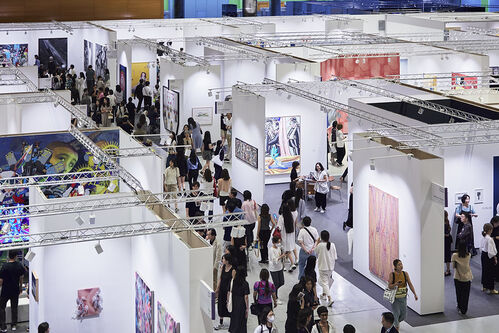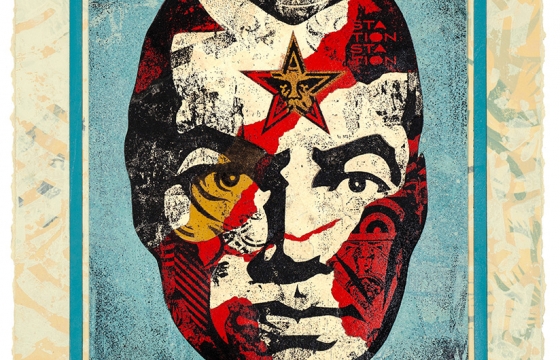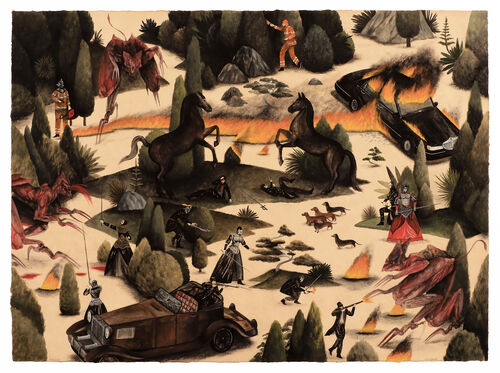Author: Feed Fetcher
Greg Vorpe: A Fingerprint on the Digital Age
The post Greg Vorpe: A Fingerprint on the Digital Age appeared first on AATONAU.
Frieze and Kiaf announce exhibitors for 2025 Seoul art fairs

Frieze and the Korean International Art Fair (Kiaf) have announced exhibitors for their respective art fairs for 2025 in Seoul, which both open concurrently from September 3rd–7th in the COEX exhibition center.
Now in its fourth iteration, Frieze Seoul 2025 will host more than 120 exhibitors from 30 countries. This year’s edition also features more than 20 newcomers from around the globe, including Athens space The Breeder, Hong Kong’s De Sarthe, and New York’s Carvalho Park. The main galleries section, featuring more than 80 exhibitors, sees blue-chip galleries such as Thaddaeus Ropac, Gagosian, and Hauser & Wirth returning to the fair, as well as Korean heavyweights such as Kukje Gallery and Gallery Baton.
Other sections at the fair are Focus Asia, featuring 10 solo presentations of emerging artists; and Frieze Masters, which will host 20 booths of works that span the Middle Ages to the 20th century. “The fair has quickly become an essential meeting point for Korean and international audiences,” said the fair’s director, Patrick Lee. The fair takes place during the third quarter, when the $200 million acquisition of the Frieze brand by an Ari Emmanuel-led venture is set to close. It will also coincide with the Armory Show in New York, which Frieze acquired in 2023.
The fair also announced a program of “Frieze Week” events and activations taking place across the Korean capital. These include late-night gallery openings, Frieze Live, Frieze Film, and Frieze Music events.
Kiaf Seoul, meanwhile, will host 176 exhibitors from over 20 countries for its 24th edition, down from 206 exhibitors at last year’s fair. More than 120 of the galleries taking part are from Korea, and the fair will also feature 22 first-time participants. These include Paris’s The Bridge Gallery, Korean space Yoonsun Gallery, and Hong Kong’s Art Of Nature Contemporary. In addition to the main galleries section, the fair will host the fourth edition of Kiaf PLUS, its curated platform for emerging artists and galleries which will feature 20 participants including Seoul’s THEO. The fair will also host panel discussions, in collaboration with Frieze and Korea Arts Management Service.
“This year, Kiaf is focusing on improving the quality of exhibition content and refining the selection of participating galleries, to continue our mission of elevating the strongest selection of both international and Korean art to our global audience,” said Sung Hoon Lee, president of the Galleries Association of Korea, which operates the event.
Featured Artist Rumjana Georgieva
Featured artist Rumjana Georgieva presents a portfolio inspired by her fascination with historical styles and genres.
The post Featured Artist Rumjana Georgieva appeared first on Artsy Shark.
Jessie Xu: Eyes That Remember, Hands That Reveal
The post Jessie Xu: Eyes That Remember, Hands That Reveal appeared first on AATONAU.
How to Be a Culture Worker in Times Like These
A New David Hammons Book Will Challenge You, Scold You, Flirt with You
Shepard Fairey: FRACTURED @ Harman Projects, San Francisco

Contemporary Artists Are Going to Hell to Capture the Modern World

For centuries, the bizarre creatures featured in the three panels of Hieronymus Bosch’s magnum opus, The Garden of Earthly Delights (ca. 1504), have enchanted other artists. Fellow Netherlander Pieter Bruegel the Elder pulled heavy inspiration from Bosch’s crowded compositions for his industrious tableaus. Bosch also inspired the Surrealists, from Salvador Dalí to Leonora Carrington. Even now, contemporary painters continue Bosch’s spirit, centering devious, demented beings in their artworks.
According to Joseph Leo Koerner, author of Bosch and Bruegel: From Enemy Painting to Everyday Life (2016), Bosch’s odd creatures were depictions of biblical evils. The wacky birds, the headless scorpions, and the man-eating dogs are “enemy presence,” or the devil’s peons encouraging bad behavior in the real-world. Humanity’s worst impulses were represented in the fantastical bacchanale style, but every creature was a stand-in for a human committing a biblical sin, like gluttony, masturbation, or rage.

Triptych of the Temptation of Saint Anthony, 1506
Hieronymus Bosch
Museo Nacional del Prado
Today, the darkness Bosch observed continues to dominate society’s psyche, but artists are depicting different terrors. In the pandemic, people read about death every day, experienced severe isolation, and developed cabin fever from lockdown. Reports showed that 2020 was laden with increased crime, mental health crises, and harassment, especially for essential workers. Several years on, these themes still reverberate throughout artists’ works. In particular, Frieze L.A. and Felix art fairs were laden with infernal scenes this year, a sign of how deeply the pandemic impacted our vision of the world, and still continues to.
One such artist was New York City oil painter, HYDEON, who cites Bosch and Bruegel as major influences. He noticed depraved behaviors escalating during the pandemic, which continue to influence his paintings five years later. He still remembers taking walks around the city in the early days of lockdown, witnessing aggression on the streets, an uptick in homelessness, and even a car on fire, which became a recurring motif in his work.

Cagnolino, 2021
Ian Ferguson (Hydeon)
Palazzo Monti

“Those things get integrated into my paintings, and then I just depict them in crazy, otherworldly ways that are so far off from the original thing that happened to me,” HYDEON, who is represented by Ricco/Maresca Gallery and Nicelle Beauchene Gallery, explained. “I like to make them whimsical.”
His paintings feel like screenshots from a time-bending video game where civil war soldiers battle cyborgs. Red demons frequently invade the compositions, as seen in his paintings The Villa (2025) and Triumph of the Willing Pt. I (2023). The horned creatures stand on their hind legs, extend their trident-like claws, and breathe fire. HYDEON has a whole backstory for these fiends. They’re cave-dwelling hermits: half alien, half human. They get high off mysterious minerals and use those hallucinations to open portals to reach the modern world, seeking even more ores for their addiction, he explained. While, at first glance, they seem unrelated to anything in the real world, HYDEON uses the demons as stand-ins for human behavior, just like Bosch.

Belle Reve, 2025
Maggie Ellis
Charles Moffett
“They represent opposition in your life. Everybody has demons. No matter how good your life is, there’s always going to be the monster mind,” HYDEON said.
Fellow New Yorker Maggie Ellis, represented by Charles Moffett, also began incorporating demons into her frenetic paintings during the pandemic. She recalls seeing stressed out faces as passersby doomscrolled on their phones. The emotions stuck with her, and today, she unleashes all the gloomy energy she absorbed through her paintings.
In addition to Bosch, she cites El Greco’s Bartholomew the Apostle (1610–14) as a major influence. In the lower left-hand corner of the late Renaissance painting, a demon lurks behind St. Bartholomew. The pointy-eared creature with wispy hairs seems to bear a childlike expression and a sinister half-smile, even though the apostle holds a metal chain that’s wrapped around its neck, keeping it in check.

Purgatory Beach, 2024
Maggie Ellis
Charles Moffett
In Ellis’s painting Purgatory Beach (2024), a similar demon with a blank stare takes center stage, poised on all fours, arching its back like a cat. A nude woman bends over him backwards, one hand bent oddly in the wrong direction, as if she’s been violently knocked into an uncanny, disjointed pose.
“I feel like there are characters in that painting, their intentions are not exactly good,” Ellis said.
Elsewhere in her works, demons keep the parties going. In Inferno (2024), a hellish crowd parties around a pillar of fire, while a demon DJs a set for the end of days. In Belle Reve (2025) ghostly apparitions haunt vampiric lounge bar diners. The creatures in both works encourage an atmosphere of self-indulgence and abandoned inhibitions. And, as some humans did in the pandemic, the demons are beginning to turn on each other. Ellis says she’s now working on a body of work where the demons are fighting, inspired by pent up rage and frustration felt during the pandemic. Today, she said, there is an additional layer of darkness she feels whenever she checks political news.

Inferno, 2024
Maggie Ellis
Charles Moffett
Embattled evil also appears in Tokyo-based painter Asami Shoji’s work. The Japanese painter, who was included in Linseed Projects’s booth at Frieze Los Angeles, often depicts large, red apparitions with bones and horns, or dark humanoid forms that beckon wailing figures into their bodies. Though figures in 24.12.29 (2024) and 24.1.20 (2024) are unmistakably demonic, Shoji doesn’t view them as demons. They often read as gentle creatures, with soft beady eyes and a serene pose.
“This world is full of contradictions—different values and meanings can exist at the same time,” Shoji wrote over email. “I think I’m painting beings in a state of evil—entities that might still transform into something good, or into something else entirely.”
Shoji sees the world as a place that has potential to heal. Sin is only a temporary state, and anyone can choose to change their moral course. Five years out from the pandemic, the darkness that wiggled into HYDEON, Ellis, and Shoji’s subconsciousness may be subsiding. In America, crime is back to pre-pandemic rates, unemployment fell, and most people surveyed by the Pew Research Center feel that they have recovered.


Even with this good news, there are still horrors brewing in the world. Authoritarian regimes still gain power, human lives are violated through war and labor, and the climate crisis is scorching the Earth. As long as people perpetuate evils, they will be represented in paintings, reimagined as the demons that dominate their minds.
Tamara Lanier on Her Historic Victory Against Harvard University

In the aftermath of the school’s agreement to relinquish the daguerreotypes of her enslaved ancestors, Lanier spoke to Hyperallergic about her protracted battle for justice and a new home for the photographs.
